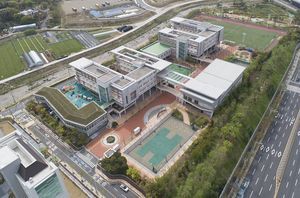Haeseong Missile Revealed: How South Korea’s Latest Weapon Outperforms the Best in Naval Combat
Daniel Kim Views

In July 2023, the Colombian Navy garnered significant attention by releasing a video on its official YouTube channel, showcasing the South Korean-made Haeseong ship-to-ship missile. The footage captured the missile’s precision as it rapidly descended vertically after launch and struck the target vessel with devastating accuracy, resulting in an immediate explosion and sinking of the ship. This demonstration, part of the multinational naval exercise UNITAS 2023, was met with enthusiastic applause from other Latin American naval forces present.
UNITAS, established in 1960, is the world’s oldest annual multinational naval exercise. During the event, the South Korean Navy highlighted its advanced weapon systems, with the Haeseong missile standing out for its remarkable performance. The Haeseong has achieved a perfect hit rate in live-fire training, cementing its status as the Navy’s most reliable anti-ship strike system.
Developed over a decade with a budget of approximately 141.1 billion won (about $105 million), the Haeseong is a product of South Korea’s Agency for Defense Development (ADD) and LIG Nex1. The missile comes in three variants: the ship-to-ship Haeseong-I, the land-attack Haeseong-II, and the submarine-launched Haeseong-III.
The Haeseong is deployed across various South Korean naval platforms, including the Chungmugong Yi Sun-sin-class destroyers, Sejong the Great-class Aegis destroyers, Yunyoungha-class fast attack craft, Incheon-class and Daegu-class frigates, and Pohang-class corvettes. It is a subsonic cruise missile, traveling at a speed of Mach 0.95, and has become a cornerstone of the Navy’s anti-ship arsenal.

The SSM-700K Haeseong-I missile, measuring 5.46 meters in length and 54 centimeters in diameter, is a prominent element of South Korea’s naval arsenal. With a maximum range exceeding 180 kilometers (approximately 112 miles) and a unit cost of around 2 billion won (about $1.5 million), it is often likened to the Harpoon missile but tailored to South Korean needs.
A key technological feature of the Haeseong-I is its advanced small turbofan jet engine, developed through collaboration with Russia. Utilizing the R95TP-300 engine from the Russian Kh-35 missile, the Haeseong-I achieves a speed of Mach 0.95. Future enhancements are anticipated to extend its range up to 400 kilometers (about 248 miles).
The Haeseong-I’s sea-skimming capability allows it to fly as low as 5 meters above the water’s surface, a maneuver designed to evade radar detection and minimize interception risks from enemy ship-to-air missiles and close-in weapon systems (CIWS).
Additionally, the missile supports multiple attack modes. Its pop-up maneuver involves ascending and diving towards the target, enhancing velocity and reducing vulnerability to defensive countermeasures. The Haeseong-I is also equipped to perform reattacks if it initially misses, with the ability to program up to eight waypoints to navigate around friendly vessels and obstacles. This ensures persistent engagement capabilities and maximizes the likelihood of a successful strike.

The Haeseong-II land-attack cruise missile, known for its supersonic speed of Mach 1, is often referred to as the “Korean Tomahawk” due to its advanced capabilities and performance. Developed as an upgrade from the Hyunmoo-III cruise missile used by the South Korean Army, the Haeseong-II is adapted for naval deployment, operated by the Navy’s 7th Mobile Task Force and Submarine Command.
With an impressive maximum range of 1,500 kilometers (approximately 932 miles), the Haeseong-II is the longest-ranged variant among the Haeseong missiles. This extended reach enables it to target significant military facilities across North Korea, including command centers, nuclear sites, and missile bases.
The Wang Geon destroyer, the first vessel to be equipped with the Haeseong-II, is one of the Korean DDH II destroyers with a displacement of 4,400 tons. Currently, six destroyers, including the Wang Geon, are equipped with vertical launch systems (KVLS) capable of carrying ten Haeseong-II missiles each, totaling 60 missiles. Additionally, the three Aegis destroyers, including the Sejong the Great, can each hold up to 30 missiles, significantly enhancing their strike capability.
The Haeseong-II is noted for its exceptional accuracy, with a margin of error comparable to the dimensions of a window. Its destructive power is sufficient to devastate an area equivalent to the size of a soccer field, making it a formidable weapon for precise and impactful strikes.

The Haeseong-III is a cutting-edge, submarine-launched, precision-guided supersonic cruise missile that stands out for its advanced capabilities and strategic impact. Operational since 2013, this missile combines speed, range, and accuracy to deliver a formidable strike capability.
Key Features and Specifications
- Speed and Range: The Haeseong-III reaches speeds of Mach 2.5 (approximately 2,600 km/h or 1,600 mph) and has a maximum range of 1,000 kilometers (about 621 miles). Its supersonic speed and extended range enable it to strike targets with high precision over considerable distances.
- Weight and Deployment: Weighing 700 kilograms (about 1,543 pounds) at launch, including its warhead, the Haeseong-III is deployed from torpedo tubes on Son Won-il-class and Dosan Ahn Chang-ho-class submarines.
- Guidance and Precision: The missile features a circular error probable (CEP) of just 1 to 3 meters, thanks to its advanced inertial navigation and terrain contour matching systems. This precision allows it to accurately target enemy vessels and facilities.
- Launch and Flight Dynamics: Upon launch from a submarine, the Haeseong-III emerges from a waterproof capsule and then ascends above the water’s surface. It maintains an altitude of 50 to 100 meters (about 164 to 328 feet) while traveling at high speed, which makes it challenging for enemy defenses to intercept.
- Operational Efficiency: The missile can execute a strike within approximately 10 minutes, considering the entire kill chain—from target detection and coordinate identification to weapon launch and flight. This rapid response time enhances its effectiveness in dynamic combat scenarios.
The Haeseong-III’s capabilities make it a significant asset in South Korea’s naval arsenal, capable of threatening not just North Korean targets but also posing strategic challenges to neighboring countries like China and Japan. Its advanced design and operational speed ensure that it remains a key element in maintaining naval superiority in the region.










Most Commented